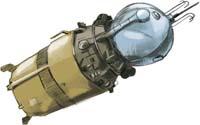The trip of Gagarin

The microbus was heading towards the launch platform. Half a dozen people inside. Two of them with white and orange hull. They looked at the rocket. The first rays of light in the morning were reflected in the bright tip of the rocket. It looked like a giant lighthouse.
The orange ones were Juri Gagarin and German Titov. The previous night they laid down early in a cabin located a couple of kilometers from the platform. But they did not manage to sleep. They did not tell anyone, for fear of not participating in the mission. They had long been preparing for it and would not miss the opportunity.
The chief designer also did not sleep all night. Gagarin and Titov circled him around the booth. For the chief designer was also a big day. He was the father of that mission. The success achieved four years earlier with Sputnik allowed him to fulfill his dream of sending a person into space.
The real name of the chief designer was the secret. Like the whole mission. It all started two years earlier. In October 1959, several young pilots were mysteriously interviewed. The pilots did not know for what; they suspected they were making a selection to test some kind of new aircraft. They asked them all kinds of questions, starting with the flight experience and their commitment to Soviet ideals. In the early 1960s, 20 selected pilots were ordered to leave their units to go to a new destination. There they would receive a special training and would have to pass hard tests.
After one year, 6 of them were selected. And in the last tests, Gagarin was in first place, young of 1,57 m of light and worker, of humble family. Titov was the second.
On April 12, 1961 both were present in the minibus. First Gagarin driver, substitute Titov. That day everyone was in good mood. There were no lack of jokes and jokes. But the tension was also evident. They came to the platform. Gagarin said a few farewell words. "I am pleased to be the first man in space, in this unprecedented confrontation with maternal nature." He embraced his companions and entered the elevator to climb the Vostok-1 spacecraft, located at the end of the rocket.
Above, a team of engineers was waiting for them to place correctly in the chair of the Gagarin capsule and close the door properly. In short, Gagarin was going to be a mere traveler. They did not know how the brain and senses responded in weightless conditions. And the spacecraft controls were also blocked for the Gagarinas. You could only unlock them with an emergency code introduced in an envelope. But at the last moment, before closing the door with 30 screws, one of the engineers said: "Juri, the code is 1-2-5". And Gagarin, eager: "I know, Kamanin has told me before."
Two hours later the chief designer informed him that everything was ready for release: "We call Zarya Kedr. The countdown begins." "Received. I am well, with courage, with desire." Gagarin heard the sound of the engines and felt the rocket in a quake. "Poiejaly! (Come!)" shouted at the radio.
The weight of the gagarins was multiplied by 5. "I feel good, the G-force and the vibrations are growing, but I take it well. I can see the Earth, the mountains, the snow, the forests...", a few seconds from the beginning of communication.
At 10 minutes it enters orbit Vostok-1 . Gagarin was fascinated by looking at the box office. He was the first to have the possibility of seeing Earth that way. "The Earth is beautiful," I would say later. But with little time I would enjoy this landscape, which was going all night.

The goal was to make a complete orbit. An hour trip and three quarters. While crossing the Pacific at night, he began to write his sensations in a notebook. There did not seem to be serious problems for basic activities. He ate and drank and looked fascinated at the blood cells that water generated in the air.
He crossed South America and travelled to Africa. He thought of his mother, how he would react upon hearing the news. And it is that, like everyone else, Gagarin's mother did not know anything about that mission either. It was kept secret until the day of launch.
Over Africa the engines of the Vostok-1 spacecraft were fitted to stop. By losing the speed he began to fall towards Earth. At this point, the capsule should be separated from the service module, but some wires did not detach, leaving both modules together. And when it began to enter the atmosphere, the spacecraft began to rotate at full speed.
The experiences of the moment were reflected in the cockpit recorder: "The container rotates chaotically. Outer layer to the fire. The outside temperature is impressive. Force G is 10. I see grey... I have been encouraged and I see it all clear again." What did not communicate to Earth was that everything was going well.
Fortunately, the cables that joined both modules were burned and the Gagarin capsule was finally free. The capsule continued to fall. Exterior almost 3.000 °C, interior 20ºC. And when it was 7,000 meters high, the capsule launched Gagarin.
When he was down in the parachute he saw a great river and discovered that it was Volga.
In the land, the peasant Anna Tajtarova, who was carrying the cow to eat, and her six-year-old grandson, Rita, stayed to avoid advancing, looking open eyes, the orange diver and the little white hull man. The man shouted: "Don't be afraid! I am a Soviet like you! I come from space and need a phone to call Moscow! ".





